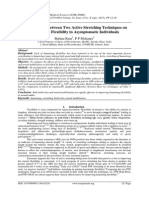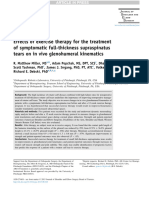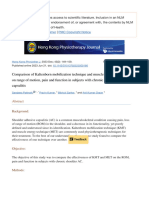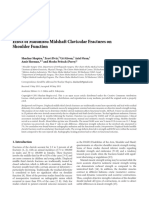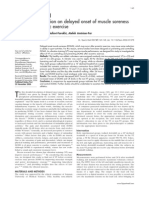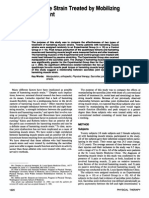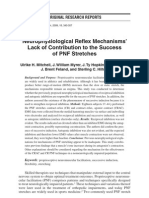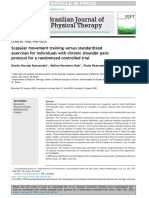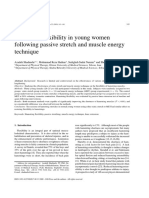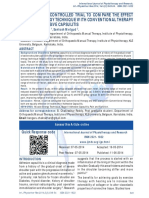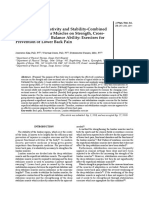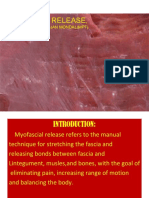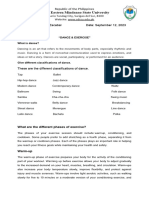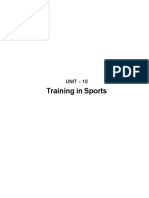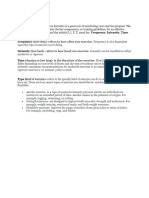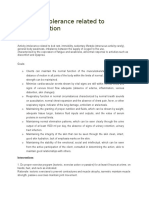Effect of Submaximal Contraction Intensity in Contract-Relax Proprioceptive Neuromuscular Facilitation Stretching
Effect of Submaximal Contraction Intensity in Contract-Relax Proprioceptive Neuromuscular Facilitation Stretching
Uploaded by
I Made Dhita PriantharaCopyright:
Available Formats
Effect of Submaximal Contraction Intensity in Contract-Relax Proprioceptive Neuromuscular Facilitation Stretching
Effect of Submaximal Contraction Intensity in Contract-Relax Proprioceptive Neuromuscular Facilitation Stretching
Uploaded by
I Made Dhita PriantharaOriginal Description:
Original Title
Copyright
Available Formats
Share this document
Did you find this document useful?
Is this content inappropriate?
Copyright:
Available Formats
Effect of Submaximal Contraction Intensity in Contract-Relax Proprioceptive Neuromuscular Facilitation Stretching
Effect of Submaximal Contraction Intensity in Contract-Relax Proprioceptive Neuromuscular Facilitation Stretching
Uploaded by
I Made Dhita PriantharaCopyright:
Available Formats
1 of 2
SHORT REPORT
Effect of submaximal contraction intensity in contract-relax proprioceptive neuromuscular facilitation stretching
J B Feland, H N Marin
............................................................................................................................... Br J Sports Med 2004;38:e18 (http://www.bjsportmed.com/cgi/content/full/38/4/e18). doi: 10.1136/bjsm.2003.010967
Objective: To determine if submaximal contractions used in contract-relax proprioceptive neuromuscular facilitation (CRPNF) stretching of the hamstrings yield comparable gains in hamstring flexibility to maximal voluntary isometric contractions (MVICs). Method: Randomised controlled trial. A convenience sample of 72 male subjects aged 1827 was used. Subjects qualified by demonstrating tight hamstrings, defined as the inability to reach 70 of hip flexion during a straight leg raise. Sixty subjects were randomly assigned to one of three treatment groups: 1, 20% of MVIC; 2, 60% of MVIC; 3, 100% MVIC. Twelve subjects were randomly assigned to a control group (no stretching). Subjects in groups 13 performed three separate six second CRPNF stretches at the respective intensity with a 10 second rest between contractions, once a day for five days. Goniometric measurements of hamstring flexibility using a lying passive knee extension test were made before and after the stretching period to determine flexibility changes. Results: Paired t tests showed a significant change in flexibility for all treatment groups. A comparison of least squares means showed that there was no difference in flexibility gains between the treatment groups, but all treatment groups had significantly greater flexibility than the control group. Conclusion: CRPNF stretching using submaximal contractions is just as beneficial at improving hamstring flexibility as maximal contractions, and may reduce the risk of injury associated with PNF stretching.
onset muscle soreness. To date, there are no studies on the effect of CRPNF stretching at lower than 50%. Therefore, the purpose of this study was to determine the effect of varying intensities (20100%) of contraction used in CRPNF stretching on improving flexibility of the hamstring muscle group.
METHODS
This was a randomised controlled clinical trial in which 72 healthy college age men (mean (SD) age 22.6 (2.03) years) qualified to participate by exhibiting tight hamstrings (defined as the inability to reach 70 hip flexion in a straight leg raise). We obtained approval from the institutional review board to use human subjects. All subjects participated in a training session on a Biodex System-3 isokinetic machine one week before actual testing to determine MVIC in a stretch position. Participants sat upright at 90 hip flexion. Only the right leg was tested. With the right leg restrained at the midthigh and ankle, a tester passively moved the lower leg through knee extension until the stretch in the hamstrings began to feel uncomfortable to the subject. The isokinetic arm was locked in position, and the subject performed a maximal isometric contraction with the hamstring muscles for six seconds, followed by 10 seconds of relaxation. During the 10 seconds of relaxation, the tester slowly extended the subjects leg further until the same level of discomfort was felt. If the subject still considered the stretch to be uncomfortable, it was kept at the previous position. The subject then performed two more six second maximal contractions (for a total of three contractions) with 10 second relaxation periods in between. Each subjects maximum contraction was calculated by taking an average of the three MVIC trials. Sixty subjects were then randomly assigned to one of three test groups: 1, 20% of MVIC; 2, 60% of MVIC; 3, 100% MVIC. Twelve subjects were assigned to a control group (no stretching). The subjects started stretching one week after the training session. They were tested each day for five days. Each subjects hamstring flexibility was measured twice a day, once before and once after stretching using a 12 inch goniometer. Participants laid supine with their left leg straight (being held to the table by an assistant), and their right leg at 90 hip flexion. The right lower leg was then passively extended to the point of initial resistance, and measured. The same tester took all flexibility measurements, but an assistant recorded the scores so the tester was blinded to previous flexibility measurements of each subject. After recording of initial flexibility levels, the subject then performed three trials on the Biodex as previously explained. All subjects contracted for six seconds followed by 10 seconds of relaxation and further extension. The only varying factor was the intensity of contraction, whether it was 20%, 60%, or 100% MVIC. Contraction torque was displayed
Abbreviations: CR, contract-relax; MVIC, maximum voluntary isometric muscle contraction; PNF, proprioceptive neuromuscular facilitation
lexibility is considered to be a valuable component of athletic performance and injury reduction. Several stretching methods, including static, ballistic, and proprioceptive neuromuscular facilitation (PNF), have been shown to increase flexibility,15 but the research is divided on which technique is most effective. PNF stretching has been reported to be more effective at improving range of motion than static or ballistic techniques.2 5 6 There are many variations of PNF stretching. The contract-relax (CR) method is a technique that uses a maximum voluntary isometric muscle contraction (MVIC) followed by relaxation. It has been shown that the most beneficial PNF contraction duration is 310 seconds, with six seconds being preferred.7 8 The correct intensity of a stretch has not been well defined, and very few studies have used different intensities in static10 and PNF8 9 stretching protocols. Contraction intensities in PNF stretching as low as 50% have been reported to produce similar flexibility gains to MVICs,9 although the primary purpose of that article was to show alterations in blood pressure. Submaximal contraction intensities could also reduce the risk of contraction induced injuries and delayed
www.bjsportmed.com
2 of 2
Feland, Marin
Table 1 Paired samples statistical analysis of change in flexibility over five days
Group 1 2 3 4 (20%) (60%) (100%) (control) df 17 16 14 11 Mean change () 5.00 4.47 5.13 0.33 SD 4.83 6.58 5.11 0.88 p Value 0.0001 0.013 0.002 0.220
whereas Magnusson et al11 suggest that PNF stretching simply alters stretch perception. The results of our study, as with Schmitt et al, lead to further questions about the role of the muscle spindle and Golgi tendon organ response to submaximal contractions. Whether submaximal contractions less than 20% would elicit a neurological response great enough to cause similar changes is not known. Future studies should try to determine an intensity threshold, as well as the effect of different contraction durations at a submaximal level.
CONCLUSIONS
visually as bar-type graph on the computer monitor to allow the subject to visually maintain a 20% or 60% contraction for each six second repetition. The 12 control subjects (group 4) were also measured twice with about five minutes between measurements to simulate the time it took to set up and stretch the subjects in the intervention groups. The use of submaximal contraction intensities of 20% and 60% MVIC in CRPNF stretching of the hamstrings yields comparable gains in flexibility to 100% MVIC. The benefit is to make the stretch more comfortable and to decrease the risk of contraction induced injury. The exact mechanism behind these results is unclear, and future research should focus on finding neurophysiological and anatomical explanations.
.....................
RESULTS
All data were analysed in SPSS version 7.5. As each subject served as his own control, paired t tests were generated to determine if a significant change in flexibility occurred within groups by comparing the flexibility measurement before the test on Monday with the flexibility measurement on Friday. Analysis of variance showed insignificant (p = 0.06) differences between treatment groups. Subjects were disqualified from participation after missing one day of testing. This gave a final sample size of 18 in group 1 (20%), 17 in group 2 (60%), 15 in group 3 (100%), and 12 in group 4 (control). The mean age of the participants was 22.6 years (range 1827). The paired t test showed that groups 1, 2, and 3 exhibited a significant change in flexibility, whereas group 4 did not significantly change (table 1).
Authors affiliations
J B Feland, H N Marin, Brigham Young University, Provo, UT 84602, USA Correspondence to: Dr Feland, Brigham Young University, RB-120A, Provo, UT 84602, USA; brent_feland@byu.edu Accepted 6 January 2004
REFERENCES
1 Sady SP, Wortman M, Blanke D. Flexibility training: ballistic, static or proprioceptive neuromuscular facilitation? Arch Phys Med Rehabil 1982;63:2613. 2 Wallin D, Ekblom B, Grahn R, et al. Improvement of muscle flexibility. A comparison between two techniques. Am J Sports Med 1985;13:2638. 3 Bandy WD, Irion JM, Briggler M. The effect of time and frequency of static stretching on flexibility of the hamstring muscles. Phys Ther 1997;77:10906. 4 Lucas RC, Koslow R. Comparative study of static, dynamic, and proprioceptive neuromuscular facilitation stretching techniques on flexibility. Percept Mot Skills 1984;58:61518. 5 Etnyre BR, Abraham LD. Gains in range of ankle dorsiflexion using three popular stretching techniques. Am J Phys Med 1986;65:18996. 6 Funk DC, Swank AM, Mikla BM, et al. Impact of prior exercise on hamstring flexibility: a comparison of proprioceptive neuromuscular facilitation and static stretching. J Strength Cond Res 2003;17:48992. 7 Cornelius WL, Rauschuber MR. The relationship between isometric contaction durations and improvement in acute hip joint flexibility. Journal of Applied Sport Science Research 1987;1:3941. 8 Schmitt GD, Pelham TW, Holt LE. A comparison of selected protocols during proprioceptive neuromuscular facilitation stretching. Clinical Kinesiology 1999;53:1621. 9 Holt LE, Pelham TW, Campagna PD. Hemodynamics during a machine-aided flexibility protocol. Can J Appl Physiol 1995;20:40716. 10 Walter J, Figoni SF, Andres FF, et al. Training intensity and duration in flexibility. Clinical Kinesiology 1996;50:405. 11 Magnusson SP, Simonsen EB, Aagaard P, et al. Mechanical and physiological responses to stretching with and without preisometric contraction in human skeletal muscle. Arch Phys Med Rehabil 1996;77:3738.
DISCUSSION
It has long been standard to perform a maximal contraction in PNF techniques. However, maximal contractions are intense enough to produce symptoms of delayed onset muscle soreness and may increase the risk of injury. The results of this pilot study suggest that contractions at 20% and 60% MVIC are just as effective as 100% MVIC during CRPNF hamstring stretching. The results also verify that all interventions improved flexibility more than no stretching (control group). Although the maximum contraction group showed greatest improvements overall, it averaged just 0.13 greater flexibility than the 20% group, which, in our opinion, is not clinically significant. One other submaximal PNF study8 suggested that PNF stretching should be submaximal (75% in their study) and progressive. Schmitt et al8 also proposed that soft tissue length may be neurologically reset through stretching, rather than permanent deformation to more resistive tissues,
www.bjsportmed.com
You might also like
- Lesson Plan ZumbaDocument4 pagesLesson Plan ZumbaPrecious Ro-An33% (3)
- Punch HarderDocument27 pagesPunch HarderJonathan Artback100% (1)
- KB Ebook V2lDocument21 pagesKB Ebook V2lCharles Lavallée100% (2)
- Wenzels AcronymsDocument10 pagesWenzels AcronymsMavra zNo ratings yet
- Effect of Core Stability Exercises and Treadmill Training On Balance in Children With Down Syndrome - Randomized Controlled TrialDocument10 pagesEffect of Core Stability Exercises and Treadmill Training On Balance in Children With Down Syndrome - Randomized Controlled TrialGayuh Candra BuanaNo ratings yet
- A Comparison Between Two Active Stretching Techniques On Hamstrings Flexibility in Asymptomatic IndividualsDocument5 pagesA Comparison Between Two Active Stretching Techniques On Hamstrings Flexibility in Asymptomatic IndividualsIOSRjournalNo ratings yet
- Chiropractic DoctorDocument4 pagesChiropractic DoctorDr. Dale MacdonaldNo ratings yet
- Jurnal DmsDocument10 pagesJurnal Dmsgracecrhitinayohanna2018No ratings yet
- Mini Research-3Document14 pagesMini Research-3Debashis SamantarayNo ratings yet
- Ações ExcentricasDocument5 pagesAções ExcentricasJonatas GomesNo ratings yet
- Temporal Pattern of The Repeated Bout Effect of Eccentric Exercise On Delayed-Onset Muscle SorenessDocument5 pagesTemporal Pattern of The Repeated Bout Effect of Eccentric Exercise On Delayed-Onset Muscle SorenessRicardo Pereira NevesNo ratings yet
- s00421 023 05184 6Document15 pagess00421 023 05184 6vmontezano2024No ratings yet
- 3A. DrAndrea R. Hegde Effect of 4 Weeks Suboccipital Muscle InhibitionDocument8 pages3A. DrAndrea R. Hegde Effect of 4 Weeks Suboccipital Muscle InhibitionfitmedmindNo ratings yet
- Miller 2016Document9 pagesMiller 2016Dario GerpeNo ratings yet
- How Long Does The Protective Effect On Eccentric Exercise-Induced Muscle Damage Last?Document6 pagesHow Long Does The Protective Effect On Eccentric Exercise-Induced Muscle Damage Last?Ricardo Pereira NevesNo ratings yet
- ARTICULO Kinesio Taping Associated With AcupunctureDocument7 pagesARTICULO Kinesio Taping Associated With AcupuncturefelipeguitastudiosNo ratings yet
- A Comparison of The Pressure Exerted On Soft Tissue by 2 Myofascial RollersDocument12 pagesA Comparison of The Pressure Exerted On Soft Tissue by 2 Myofascial RollersBruno DiasNo ratings yet
- Comparison of Kaltenborn Mobilization Technique and Muscle Energy Technique On Range of Motion, Pain and Function in Subjects With Chronic Shoulder Adhesive Capsulitis - PMCDocument17 pagesComparison of Kaltenborn Mobilization Technique and Muscle Energy Technique On Range of Motion, Pain and Function in Subjects With Chronic Shoulder Adhesive Capsulitis - PMCvitoria costaNo ratings yet
- Physiotherapy: P. Ratan Khuman Lourembam Surbala Priyanka Patel Dhara ChavdaDocument4 pagesPhysiotherapy: P. Ratan Khuman Lourembam Surbala Priyanka Patel Dhara ChavdaSahithya MNo ratings yet
- Injury AnalysisDocument5 pagesInjury AnalysisCiro SpagnelliNo ratings yet
- Orthopaedic JournalDocument6 pagesOrthopaedic JournalZiad AlazthaNo ratings yet
- Influence of Vibration On Delayed Onset of Muscle Soreness Following Eccentric ExerciseDocument4 pagesInfluence of Vibration On Delayed Onset of Muscle Soreness Following Eccentric ExerciseNoseXXNo ratings yet
- 4A. Ushaben Mahendrakumar Prajapati Effect - of - Suboccipital - (Healthy Adults)Document8 pages4A. Ushaben Mahendrakumar Prajapati Effect - of - Suboccipital - (Healthy Adults)fitmedmindNo ratings yet
- 5-Repetition Sit-To-Stand Test in Subjects With Chronic StrokeDocument7 pages5-Repetition Sit-To-Stand Test in Subjects With Chronic StrokeDhieto Basuki PutraNo ratings yet
- Effect of 3 Different Active Stretch Durations On Hip Flexion Range of MotionDocument7 pagesEffect of 3 Different Active Stretch Durations On Hip Flexion Range of MotionchrisNo ratings yet
- Tracción ColumnaDocument12 pagesTracción ColumnaJair Guerrero TorresNo ratings yet
- Effect of Myofascial Release Therapy and Active Stretching On Pain and Grip Strength in Lateral EpicondylitisDocument4 pagesEffect of Myofascial Release Therapy and Active Stretching On Pain and Grip Strength in Lateral EpicondylitisAnonymous B5JFIx58QNo ratings yet
- 5A. Himanshi Sharma Effectiveness - of - Sub (College Studens)Document15 pages5A. Himanshi Sharma Effectiveness - of - Sub (College Studens)fitmedmindNo ratings yet
- Am J Sports Med 2004 Witvrouw 1122 30Document10 pagesAm J Sports Med 2004 Witvrouw 1122 30RosaneLacerdaNo ratings yet
- Pi Is 000399931300453 XDocument7 pagesPi Is 000399931300453 XFarhaanKhanHaleemNo ratings yet
- Effect of Jumping Exercise On Muscle Strength and Balance of Elderly People: A Randomized Controlled TrialDocument4 pagesEffect of Jumping Exercise On Muscle Strength and Balance of Elderly People: A Randomized Controlled TrialAntonia SanchezNo ratings yet
- Hamstring Muscle Strain Treated by Mobilizing The Sacroiliac JointDocument4 pagesHamstring Muscle Strain Treated by Mobilizing The Sacroiliac JointKarthik BhashyamNo ratings yet
- Jibi Paul Pradeep Balakrishnan Mohd Izham: BackgroundDocument5 pagesJibi Paul Pradeep Balakrishnan Mohd Izham: Backgroundjul yanNo ratings yet
- Journal PresentationDocument24 pagesJournal PresentationS M Rakibul IslamNo ratings yet
- Mitchell Et Al. (2009) Reflex Mechanisms Lack of ContributionDocument16 pagesMitchell Et Al. (2009) Reflex Mechanisms Lack of ContributionRafael RodriguesNo ratings yet
- The Impact of Whole Body Vibration Therapy On Spasticity and Disability of The Patients With Poststroke HemiplegiaDocument6 pagesThe Impact of Whole Body Vibration Therapy On Spasticity and Disability of The Patients With Poststroke HemiplegialabsoneducationNo ratings yet
- Kamonseki 2020Document10 pagesKamonseki 2020Nicol Sandoval SotoNo ratings yet
- 1802 HGDocument6 pages1802 HGDavid SugiartoNo ratings yet
- WORRELL Et Al., 1994Document6 pagesWORRELL Et Al., 1994Ismenia HelenaNo ratings yet
- The Effect of Core Stabilization Exercises Using A Sling On Pain and Muscle Strength of Patients With Chronic Low Back PainDocument4 pagesThe Effect of Core Stabilization Exercises Using A Sling On Pain and Muscle Strength of Patients With Chronic Low Back PainThanwarat PongvichaiNo ratings yet
- E Vects of Three Diverent Training Modalities On The Cross Sectional Area of The Lumbar Multifidus Muscle in Patients With Chronic Low Back PainDocument6 pagesE Vects of Three Diverent Training Modalities On The Cross Sectional Area of The Lumbar Multifidus Muscle in Patients With Chronic Low Back PainGary LeeNo ratings yet
- Wu Yung T RF Supraescapular Anesth Analg 2014Document7 pagesWu Yung T RF Supraescapular Anesth Analg 2014fernandomurcianoNo ratings yet
- Flexibilidade Dos Isquiotibiais em Mulheres Jovens Após TécnicaDocument7 pagesFlexibilidade Dos Isquiotibiais em Mulheres Jovens Após TécnicaAdilson MarquesNo ratings yet
- SCS TRAPEZIUSDocument4 pagesSCS TRAPEZIUSpradeep6288No ratings yet
- DS Ahmed A. R. 2011Document6 pagesDS Ahmed A. R. 2011jul yanNo ratings yet
- MET Vs ConventionalDocument6 pagesMET Vs ConventionalPoorvin ShahNo ratings yet
- The Effectiveness of Spinal Manipulation in Increasing Muscle Strength in Healthy Individuals A Systematic Review and Meta-AnalysisDocument11 pagesThe Effectiveness of Spinal Manipulation in Increasing Muscle Strength in Healthy Individuals A Systematic Review and Meta-Analysisdummyy1256No ratings yet
- Test-Retest Reliability of Hand-Held Dynamometry During A Single Session of Strength AssessmentDocument4 pagesTest-Retest Reliability of Hand-Held Dynamometry During A Single Session of Strength AssessmentLotfi TrabelsiNo ratings yet
- Immediate Effects of 2 Types of Braces On Pain and Grip Strength in People With Lateral Epicondylalgia: A Randomized Controlled TrialDocument9 pagesImmediate Effects of 2 Types of Braces On Pain and Grip Strength in People With Lateral Epicondylalgia: A Randomized Controlled TrialRodrigo HamadaNo ratings yet
- Hamstring Stretches Frequency Required To Maintain Knee Extension Range of MotionDocument8 pagesHamstring Stretches Frequency Required To Maintain Knee Extension Range of MotionRabiaNo ratings yet
- 2001 Stretching VJDocument5 pages2001 Stretching VJDimitrisNo ratings yet
- Effects of Horizontal and Incline Bench Press On Neuromuscular Adaptations in Untrained Young MenDocument14 pagesEffects of Horizontal and Incline Bench Press On Neuromuscular Adaptations in Untrained Young MenAndré Evandro MartinsNo ratings yet
- Effect of Isometric Quadriceps Exercise On Muscle StrengthDocument7 pagesEffect of Isometric Quadriceps Exercise On Muscle StrengthAyu RoseNo ratings yet
- Effect of Kinesio Taping On Muscle Strength in Athletes - A Pilot StudyDocument4 pagesEffect of Kinesio Taping On Muscle Strength in Athletes - A Pilot StudyErnesto LlorcaNo ratings yet
- 2A. Sung-Hak CHo The Comparison of The Immediate EffectsDocument3 pages2A. Sung-Hak CHo The Comparison of The Immediate EffectsfitmedmindNo ratings yet
- 23 247Document4 pages23 247Ita MagdalenaNo ratings yet
- J JBMT 2007 10 001 PDFDocument11 pagesJ JBMT 2007 10 001 PDFhectorlekepi92No ratings yet
- Immediate Effect of M2T Blade On Hamstring Flexibility in Elderly Population A Pilot StudyDocument3 pagesImmediate Effect of M2T Blade On Hamstring Flexibility in Elderly Population A Pilot StudyTanvi PathaniaNo ratings yet
- EMG en UCI - Club de Revista PDFDocument6 pagesEMG en UCI - Club de Revista PDFJOSE JULIAN BERNAL SANCHEZNo ratings yet
- Examination of Shoulder Positioning After Stroke: A Randomised Controlled Pilot TrialDocument6 pagesExamination of Shoulder Positioning After Stroke: A Randomised Controlled Pilot TrialAnggelia jopa sariNo ratings yet
- Klapp MethodDocument7 pagesKlapp MethodRJLeddaNo ratings yet
- Changes in Lower Limb Strength and Function Following Lumbar Spinal MobilizationDocument10 pagesChanges in Lower Limb Strength and Function Following Lumbar Spinal Mobilizationdummyy1256No ratings yet
- Effect of Task-Oriented Training and Neurodevelopmental Treatment On The Sitting Posture in Children With Cerebral PalsyDocument3 pagesEffect of Task-Oriented Training and Neurodevelopmental Treatment On The Sitting Posture in Children With Cerebral PalsyPhysio SauravNo ratings yet
- Myśliwiec Et Al (2012) Evaluación de La Amplitud de Movimiento de La Columna Cervical Tras El Uso Del Dispositivo de Tracción Saunders en Diferentes Posiciones de Las Extremidades SuperioresDocument3 pagesMyśliwiec Et Al (2012) Evaluación de La Amplitud de Movimiento de La Columna Cervical Tras El Uso Del Dispositivo de Tracción Saunders en Diferentes Posiciones de Las Extremidades SuperioresMarcos MattielloNo ratings yet
- Length Tension Testing Book 1, Lower Quadrant: A Workbook of Manual Therapy TechniquesFrom EverandLength Tension Testing Book 1, Lower Quadrant: A Workbook of Manual Therapy TechniquesRating: 3.5 out of 5 stars3.5/5 (3)
- International Journal of Current Advanced Research International Journal of Current Advanced ResearchDocument5 pagesInternational Journal of Current Advanced Research International Journal of Current Advanced ResearchI Made Dhita PriantharaNo ratings yet
- Literature Review and Research in Physiotherapy Curriculum: Some ReflectionsDocument3 pagesLiterature Review and Research in Physiotherapy Curriculum: Some ReflectionsI Made Dhita PriantharaNo ratings yet
- Myofascial Release,: Presented By-Debanjan Mondal (MPT)Document105 pagesMyofascial Release,: Presented By-Debanjan Mondal (MPT)I Made Dhita PriantharaNo ratings yet
- 10 Aligizakis HadjipavlouDocument9 pages10 Aligizakis HadjipavlouI Made Dhita PriantharaNo ratings yet
- Anterior Versus Posterior Surgical Approach For Lumbosacral TuberculosisDocument9 pagesAnterior Versus Posterior Surgical Approach For Lumbosacral TuberculosisI Made Dhita PriantharaNo ratings yet
- Neurophysiological ApproachesDocument20 pagesNeurophysiological ApproachesI Made Dhita PriantharaNo ratings yet
- New CPG For Torticollis .1 PDFDocument1 pageNew CPG For Torticollis .1 PDFI Made Dhita PriantharaNo ratings yet
- Jpts 27 2151Document4 pagesJpts 27 2151I Made Dhita PriantharaNo ratings yet
- Edgar Dale's Pyramid of Learning in Medical Education: A Literature ReviewDocument10 pagesEdgar Dale's Pyramid of Learning in Medical Education: A Literature ReviewI Made Dhita PriantharaNo ratings yet
- Section 27 Ergonomics and Body MechanicsDocument6 pagesSection 27 Ergonomics and Body MechanicsI Made Dhita PriantharaNo ratings yet
- 4-Week Total Body Program Part 1Document60 pages4-Week Total Body Program Part 1lehliemNo ratings yet
- Pathfit 3Document3 pagesPathfit 3Bernadeth Dizon Amoguis EscabalNo ratings yet
- 12 Physical Education Chapter 10Document23 pages12 Physical Education Chapter 10RiyaNo ratings yet
- PE class 12 ch 10Document14 pagesPE class 12 ch 10maanyasoni2912No ratings yet
- 15 Simple Concentration Exercises You Should Try: Skip To ContentDocument11 pages15 Simple Concentration Exercises You Should Try: Skip To Contentsharma_jb08100% (1)
- HRF PowerpointDocument19 pagesHRF PowerpointClaire Montero-MasutaNo ratings yet
- UTS Bahasa Inggris Kelas 4Document1 pageUTS Bahasa Inggris Kelas 4sucifitriani94No ratings yet
- Ashtanga Yoga - PatanjaliDocument2 pagesAshtanga Yoga - PatanjaliShruti KhanduriNo ratings yet
- Training Percentages Made SimpleDocument15 pagesTraining Percentages Made SimplealigaramNo ratings yet
- FITT Principle Assign.Document2 pagesFITT Principle Assign.pantaleonalvin064No ratings yet
- PHYSICAL FITNESS AutosavedDocument14 pagesPHYSICAL FITNESS AutosavedJarnel CabalsaNo ratings yet
- American Muscle & Fitness Kick Boxing Aerobics ManualDocument37 pagesAmerican Muscle & Fitness Kick Boxing Aerobics Manualfavoloso1No ratings yet
- Details of Hatha Yoga Text ChartsDocument3 pagesDetails of Hatha Yoga Text ChartsNilam ShawNo ratings yet
- Yessis - RepetitionsDocument2 pagesYessis - Repetitionsryan987180% (5)
- Quarterfinals - Age Groups: Tests 2A and 2BDocument12 pagesQuarterfinals - Age Groups: Tests 2A and 2BXiaoNo ratings yet
- Year 11: Task: Create A 2-Week Fitness Plan For Yourself Which You Can Complete and Track DailyDocument4 pagesYear 11: Task: Create A 2-Week Fitness Plan For Yourself Which You Can Complete and Track DailyYun Ho CHONo ratings yet
- Personal Health Assessment and Health Promotion PlanDocument16 pagesPersonal Health Assessment and Health Promotion Planapi-251834934No ratings yet
- Activity Intolerance Related To ImmobilizationDocument3 pagesActivity Intolerance Related To ImmobilizationAgronaSlaughterNo ratings yet
- Athletes Performance Training StrategiesDocument3 pagesAthletes Performance Training StrategiesDanCurtisNo ratings yet
- Pull Up EbookDocument12 pagesPull Up EbookDanko Kovačević100% (2)
- 1 MapehDocument4 pages1 MapeheboypjmsNo ratings yet
- Grade 11 2nd Sem Week 1 To 4Document26 pagesGrade 11 2nd Sem Week 1 To 4Julius Romeo Capeña CaisipNo ratings yet
- Unit VI. Muscular Fitness (Strength and Endurance) and AssessmentDocument23 pagesUnit VI. Muscular Fitness (Strength and Endurance) and AssessmentGohan Dave AgmataNo ratings yet
- Yr 7 Lesson5 Chester Step TestDocument4 pagesYr 7 Lesson5 Chester Step Testapi-307545096No ratings yet
- WritingDocument22 pagesWritingYounes El ManzNo ratings yet





